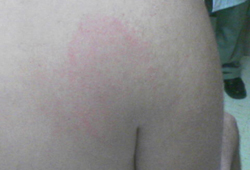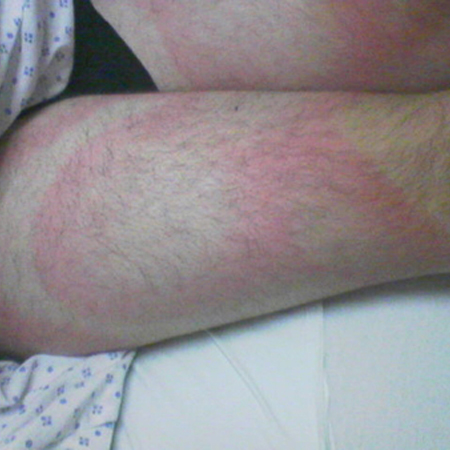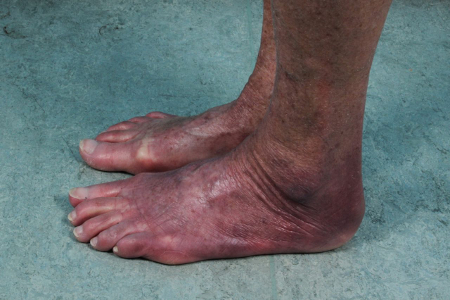Case history
Case history
An 18-year-old man presents in July with a 1-week history of non-pruritic, erythematous rash with low-grade fever and arthralgias. On examination, the patient has multiple skin lesions, about 4 cm to 10 cm in diameter, with central clearing. The patient had significant outdoor exposure, but there was no recollection of a tick or insect bite.
Other presentations
Early Lyme disease includes erythema migrans and early disseminated infection (multiple erythema migrans lesions, carditis, cranial nerve palsy [most commonly cranial nerve VII], aseptic meningitis, or acute radiculopathy). The differences in Borrelia genospecies between the continents result in differences in clinical presentation.[1]
Erythema migrans (EM), the most common presentation, can be seen in 50% to 90% of patients and is a pathognomic feature of Lyme disease . It develops at the site of a tick bite, usually within 1 to 2 weeks; in contrast, a reactive tick bite rash may develop within hours to days, is associated with itching and warmth of the skin, and generally fades after several days.[1] EM is a non-tender, non-pruritic, annular expanding skin lesion that may be homogeneously erythematous or have central clearing (bull's eye) and is generally 5 cm or greater in diameter.[Figure caption and citation for the preceding image starts]: Erythema migransFrom the personal collection of Dr Cristian Speil; used with permission [Citation ends]. [Figure caption and citation for the preceding image starts]: Erythema migransFrom the personal collection of Dr Cristian Speil; used with permission [Citation ends].
[Figure caption and citation for the preceding image starts]: Erythema migransFrom the personal collection of Dr Cristian Speil; used with permission [Citation ends].
B burgdorferi ss and B garinii usually lead to homogeneous EM, as opposed to B afzelii-related EM, which is characterised by central clearing in 60% of cases.[1] Central clearing is therefore less common in patients in endemic areas of the US (seen in approximately 20% of patients) compared with non-endemic areas of the US and Europe (seen in approximately 80% of patients).[2] EM is often accompanied by constitutional symptoms such as fever and arthralgias.[3] Untreated solitary EM lesions usually improve within a few days to a few weeks. Multiple lesions can occur as the organism disseminates from the primary site of infection. In Europe, the primary site of skin infection generally shows a more indolent form of EM lesion, with less inflammation and slower progression.[3]
Borrelial lymphocytoma, a rare cutaneous manifestation, presents as a solitary painless bluish-red swelling commonly on the ear lobe, near the nipple or in the scrotal area. It is seen mainly in Europe and is usually caused by Borrelia garinii or B afzelii.[1] It is predominantly reported in children. Often, there is a preceding or concomitant erythema migrans. With antibiotic treatment, borrelial lymphocytoma usually resolves within several weeks.[1]
[Figure caption and citation for the preceding image starts]: Borrelial lymphocytomaGzzz, CC BY-SA 4.0 via Wikimedia Commons; used with permission [Citation ends].
Musculoskeletal manifestations include arthralgia and arthritis. Arthritis typically presents with recurrent brief attacks of joint swelling in 1 or more joints, typically involving the knees, three to six months after infection. If untreated, patients can experience intermittent or persistent joint swelling. With antibiotic treatment, the arthritis is cured in most cases, but in some patients, proliferative synovitis can persist for months or several years. B burgdorferi ss in North America is more arthritogenic than other genotypes, so Lyme arthritis is more common in North America (28% of cases) than Europe (3% to 7% of cases).[1]
Neurological manifestations, known collectively as Lyme neuroborreliosis, are reported in around 10% of cases of Lyme disease.[1] Early symptoms usually present days to weeks after a tick bite, as a lymphocytic meningitis, cranial nerve palsy (most commonly affecting the facial nerve [cranial nerve VII]), or radiculoneuropathy. In the US, the most common manifestation of early Lyme neuroborreliosis is facial palsy.[3] It may be bilateral in up to 25% of patients and is more common in children than adults.[1] Other presentations include subacute meningitis and, less commonly, radiculoneuritis.[3] In Europe, B garinii is particularly neurotropic, and neuroborreliosis typically presents with painful radiculoneuritis and lymphocytic meningitis, with or without cranial neuritis.[1] This triad of symptoms is known as Bannwarth syndrome's and was reported several decades before the aetiology of Lyme borreliosis was established.[4] Patients with meningitis typically have a relatively high concentration of lymphocytes in the cerebrospinal fluid (pleocytosis).[5]
During early disseminated infection, acute cardiovascular complications include carditis with atrioventricular block (second- or third-degree) that resolves in days to weeks and, less commonly, myopericarditis or, rarely, cardiomyopathy. Lyme carditis is usually self-limited, but can be potentially fatal if untreated.[1]
Late manifestations (>6 months after exposure) of Lyme disease include arthritis (chronic monoarthritis or asymmetrical oligoarthritis), neurological involvement (encephalopathy, encephalomyelitis, peripheral neuropathy, and chronic progressive meningoencephalitis), and acrodermatitis chronica atrophicans (ACA). ACA is a chronic and slowly progressive skin condition with bluish-red atrophic skin lesions on sun-exposed surfaces of the extremities. It is seen in 1% to 3% of Lyme disease cases in Europe and is caused by Borrelia afzelii.[1] It is virtually absent in North America. Concurrent peripheral neuropathy is common, and local joint involvement may occur.[1]
[Figure caption and citation for the preceding image starts]: Acrodermatitis chronica atrophicansNguyen AL et al. Case Reports 2016; 2016: bcr2016216033; used with permission [Citation ends].
Use of this content is subject to our disclaimer